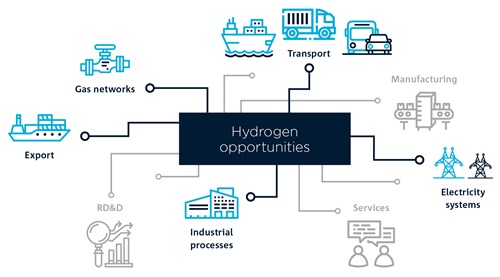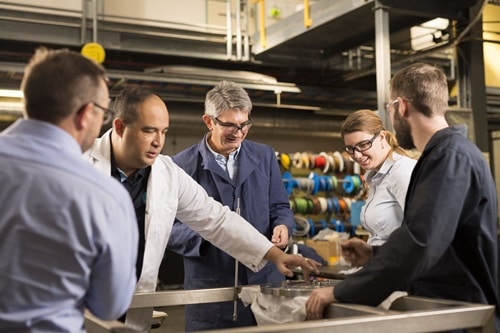Australia’s national science agency, the CSIRO, has launched a new $68 million Hydrogen Industry Mission (Mission) with the aim of driving the cost of hydrogen production to under $2/kg as the National Hydrogen Strategy seeks to establish the country in the driver’s seat of the global hydrogen economy by 2030.
CSIRO Chief Executive Larry Marshall said this “unique mission-based partnership” is key to the development of a new future fuels industry for both Australian domestic use but also for export.
According to a 2019 Deloitte report, Australia’s potential hydrogen sector could create thousands of jobs and increase national GDP by up to $26 billion. Goldman Sachs has called green hydrogen a “once-in-a-generation opportunity” and estimated that green hydrogen alone (not including grey and blue) “could give rise to a €10 trillion addressable market globally by 2050 for the utilities industry alone.”
That $68 million will go to more than 100 projects over the next five years with collaborators Toyota and Hyundai, and operated by an array of partners including:
- The Australian Renewable Energy Agency (ARENA)
- The Department of Industry, Science, Energy and Resources (DISER)
- Fortescue Metals Group (FMG)
- Swinburne University
- The Victorian Government
- Future Fuels CRC
- National Energy Resources Australia (NERA)
- Australian Hydrogen Council
“Australia can become a renewable energy leader through the production, use and export of hydrogen,” said Marshall, “but it will only become a reality if we breakthrough the $2/kg barrier. That needs Australia’s world class science working with CSIRO’s commercialisation expertise turning breakthrough science into real-world solutions.”
Marshall believes that only a national mission “Team Australia” style approach will get this industry developed against the clock. “Taking a Team Australia approach is essential to creating the 8,000 jobs and $11 billion a year in GDP that hydrogen can contribute to Australia’s economy as we build back better from the impacts of Covid-19.”

Australian Hydrogen Council CEO Fiona Simon agreed that a concerted and collaborative mission was the way forward. “We need a coordinated series of investments in industrial-scale research and demonstration activities,” said Simon, “along with the supporting research and infrastructure that can bring the technologies that are available and emerging to the industry that needs to deploy them.”
According to Patrick Hartley, CSIRO’s Hydrogen Industry Mission Lead, the CSIRO’s “unique position at the nexus of research, government and industry gives us the ability to bring together stakeholders, and our track record of partnering and leveraging research funds means that we are able to grow this new phase of the industry without the need for everyone to do it alone.”
According to the CSIRO, the Mission has been divided into four key categories:
- Hydrogen Knowledge Centre to capture and promote hydrogen projects and industry developments across Australia. The first module, HyResource, was launched in September with NERA, the Future Fuels CRC and The Australian Hydrogen Council.
- Feasibility and strategy studies to deliver trusted advice to government, industry and the community. This builds on recent hydrogen cost modelling and barrier analysis provided as part of developing the National Hydrogen Strategy.
- Demonstration projects that validate hydrogen value chains and de-risk enabling technologies. Development is underway at a new facility in Clayton, Victoria, with Swinburne University and the Victorian Government.
- Enabling science and technology through investment in breakthrough science, including a $20m partnership with Fortescue which focuses on the development and commercialisation of new hydrogen technologies.
Australia’s Chief Scientist, Dr Cathy Foley, backed the Mission saying Australia must be “bold and ambitious when it comes to transitioning towards a low-emissions economy. Hydrogen is well placed to be a key element in this transition, but the emerging Australian hydrogen industry is at a critical stage. Research development and demonstration partnerships like we are seeing as part of CSIRO’s Hydrogen Industry Mission are vital to enabling the development and growth of this exciting new industry.”
This content is protected by copyright and may not be reused. If you want to cooperate with us and would like to reuse some of our content, please contact: editors@pv-magazine.com.









2 comments
By submitting this form you agree to pv magazine using your data for the purposes of publishing your comment.
Your personal data will only be disclosed or otherwise transmitted to third parties for the purposes of spam filtering or if this is necessary for technical maintenance of the website. Any other transfer to third parties will not take place unless this is justified on the basis of applicable data protection regulations or if pv magazine is legally obliged to do so.
You may revoke this consent at any time with effect for the future, in which case your personal data will be deleted immediately. Otherwise, your data will be deleted if pv magazine has processed your request or the purpose of data storage is fulfilled.
Further information on data privacy can be found in our Data Protection Policy.